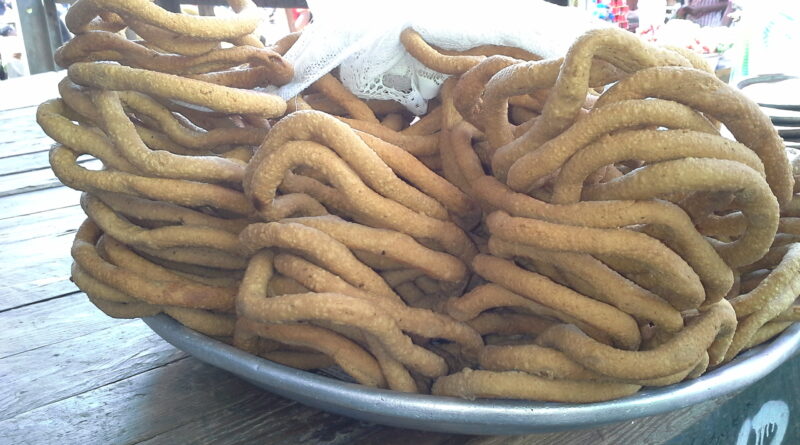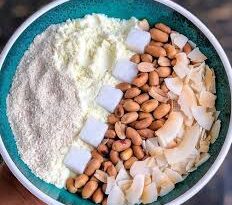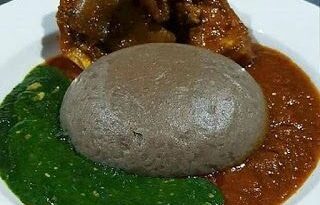Kuli-kuli
Kuli-Kuli: The Crunchy Delight of West African Cuisine
Introduction
West African cuisine is a rich and diverse tapestry of flavors, ingredients, and culinary traditions. Among the many delectable treats that have captured the hearts and palates of people across the region is Kuli-kuli. This crunchy, peanut-based snack is not only a beloved comfort food but also a symbol of the ingenuity and resourcefulness of West African cooks. In this article, we will delve into the history, preparation methods, cultural significance, and various ways to enjoy Kuli-kuli. We will also explore its nutritional benefits and modern adaptations that have kept this traditional snack relevant in today’s culinary landscape.
The Origins of Kuli-Kuli
Kuli-kuli is a traditional West African snack made from groundnuts (peanuts) that have been roasted, ground, and fried. It is especially popular in Nigeria, Ghana, and other parts of West Africa, where it is enjoyed as a snack, condiment, or ingredient in various dishes.
The origins of Kuli-kuli can be traced back to the Hausa people of northern Nigeria, who are known for their culinary skills and innovative use of locally available ingredients. Groundnuts, which were introduced to West Africa by Portuguese traders in the 16th century, quickly became a staple crop in the region due to their adaptability and nutritional value. The Hausa people developed Kuli-kuli as a way to utilize the by-products of groundnut oil extraction, ensuring that nothing went to waste.
The Preparation of Kuli-Kuli
The process of making Kuli-kuli is both simple and ingenious. It involves a series of steps that transform raw groundnuts into a crunchy and flavorful snack. Here’s a detailed guide to preparing Kuli-kuli:
Ingredients
- Raw groundnuts (peanuts): 2 cups
- Salt: to taste
- Spices: optional (such as ginger, chili powder, or garlic)
- Oil: for frying (groundnut oil is traditional, but any neutral oil can be used)
Preparation Steps
- Roasting the Groundnuts: Begin by roasting the raw groundnuts over medium heat until they are golden brown and fragrant. This can be done in a dry pan on the stove or in an oven. Roasting enhances the flavor of the groundnuts and makes them easier to grind.
- Grinding the Groundnuts: Once the groundnuts have cooled, grind them into a smooth paste using a mortar and pestle, a food processor, or a blender. If using a blender or food processor, you may need to add a small amount of water to help the grinding process. The goal is to achieve a thick, smooth paste.
- Extracting the Oil: Place the groundnut paste in a clean cloth or cheesecloth and squeeze out the oil. This step is crucial as it helps to remove excess oil from the paste, making the Kuli-kuli crunchy rather than greasy. The extracted oil can be set aside and used for frying the Kuli-kuli or for other culinary purposes.
- Shaping the Kuli-Kuli: Transfer the defatted groundnut paste to a mixing bowl and add salt to taste. You can also add spices such as ginger, chili powder, or garlic for extra flavor. Mix the paste thoroughly, then shape it into small, bite-sized balls, sticks, or any desired shape.
- Frying the Kuli-Kuli: Heat the oil in a deep pan or frying pot over medium-high heat. Once the oil is hot, carefully drop the shaped groundnut paste into the oil and fry until golden brown and crispy. This usually takes about 5-10 minutes. Use a slotted spoon to remove the Kuli-kuli from the oil and place them on a paper towel-lined plate to drain excess oil.
- Cooling and Storing: Allow the Kuli-kuli to cool completely before storing them in an airtight container. Properly stored, Kuli-kuli can stay fresh and crunchy for several weeks.
Cultural Significance of Kuli-Kuli
Kuli-kuli is more than just a snack; it is a cultural icon in West Africa. Its origins among the Hausa people highlight its significance as a symbol of ingenuity and resourcefulness. The process of making Kuli-kuli involves utilizing every part of the groundnut, reflecting the frugal and sustainable practices that are deeply ingrained in West African culture.
In many West African households, Kuli-kuli is a staple snack that is enjoyed by people of all ages. It is often served with a variety of dishes, adding a crunchy texture and nutty flavor that enhances the overall eating experience. For example, Kuli-kuli is commonly crumbled over salads, mixed with traditional dishes like fufu and gari, or enjoyed on its own as a satisfying treat.
Kuli-kuli also holds a special place in social and communal settings. It is frequently shared during gatherings, festivals, and celebrations, where it is offered as a gesture of hospitality and goodwill. The snack’s affordability and wide availability make it accessible to people from all walks of life, further cementing its status as a beloved and unifying food.
Nutritional Benefits of Kuli-Kuli
Kuli-kuli is not only delicious but also packed with nutritional benefits. As a product made from groundnuts, it is rich in protein, healthy fats, vitamins, and minerals. Here are some of the key nutritional components of Kuli-kuli:
- Protein: Groundnuts are an excellent source of plant-based protein, which is essential for building and repairing tissues, supporting immune function, and maintaining overall health.
- Healthy Fats: Kuli-kuli contains monounsaturated and polyunsaturated fats, which are beneficial for heart health. These healthy fats help to lower bad cholesterol levels and reduce the risk of heart disease.
- Vitamins and Minerals: Groundnuts are rich in vitamins and minerals such as vitamin E, magnesium, and potassium. Vitamin E is an antioxidant that protects cells from damage, while magnesium and potassium are important for maintaining healthy blood pressure and muscle function.
- Fiber: Kuli-kuli contains dietary fiber, which aids in digestion, promotes a feeling of fullness, and helps to regulate blood sugar levels.
Modern Adaptations and Variations of Kuli-Kuli
While traditional Kuli-kuli remains popular, modern adaptations and variations have emerged, reflecting changing tastes and culinary innovations. These contemporary versions often incorporate new ingredients and flavors, making Kuli-kuli even more versatile and appealing to a broader audience.
Flavored Kuli-Kuli
Adding different spices and seasonings to the groundnut paste before frying can create unique and flavorful variations of Kuli-kuli. Some popular additions include:
- Chili Powder: For those who enjoy a spicy kick, adding chili powder to the groundnut paste creates a fiery and flavorful Kuli-kuli.
- Garlic and Ginger: These aromatic spices enhance the nutty flavor of the groundnuts and add a delicious depth of flavor.
- Herbs: Fresh or dried herbs such as thyme, rosemary, or basil can be mixed into the paste for a fragrant and savory twist.
Kuli-Kuli Bars
Incorporating Kuli-kuli into energy bars is a modern and convenient way to enjoy this traditional snack. By combining ground Kuli-kuli with ingredients like oats, dried fruits, and honey, you can create nutritious and portable bars that are perfect for on-the-go snacking.
Kuli-Kuli in Baked Goods
Ground Kuli-kuli can be used as an ingredient in various baked goods, adding a unique flavor and crunchy texture. For example, you can incorporate Kuli-kuli into cookies, cakes, and bread for a delicious and nutty twist.
Kuli-Kuli in Popular Culture
Kuli-kuli has a significant presence in West African popular culture. It is frequently mentioned in songs, movies, and literature as a symbol of traditional values and resilience. The snack’s humble origins and nutritional value have made it a subject of pride and nostalgia for many West Africans.
In recent years, there has been a renewed interest in traditional foods like Kuli-kuli, driven by a growing awareness of the importance of preserving cultural heritage and promoting healthy eating. Food bloggers, chefs, and culinary enthusiasts are increasingly featuring Kuli-kuli in their recipes and social media posts, showcasing its versatility and appeal to a broader audience.
The Joy of Making and Sharing Kuli-Kuli
For many West Africans, the process of making and sharing Kuli-kuli is a communal activity that brings people together. The preparation of the snack often involves multiple steps that require cooperation and coordination, fostering a sense of community and togetherness.
Elders in the community play a crucial role in passing down the knowledge and techniques for making Kuli-kuli to younger generations. This transmission of culinary skills ensures that the tradition of making Kuli-kuli continues to thrive, preserving an important aspect of West African cultural heritage.
Kuli-Kuli and Sustainability
The process of making Kuli-kuli is a testament to the resourcefulness and sustainability practices of West African cooks. By using the by-products of groundnut oil extraction, nothing goes to waste, and every part of the groundnut is utilized. This approach not only minimizes waste but also maximizes the nutritional benefits of the groundnuts.
Furthermore, the ingredients used to make Kuli-kuli are locally sourced and readily available, reducing the need for imported goods and supporting local economies. The snack’s long shelf life also makes it a practical and sustainable food option, as it can be stored for extended periods without spoiling.
Conclusion
Kuli-kuli is a beloved and iconic snack that embodies the rich culinary heritage and cultural resilience of West Africa. From its humble origins as a by-product of groundnut oil extraction to its status as a popular and nutritious treat, Kuli-kuli has remained a staple



